
New York State farm family
constructs award-winning concrete manure storage tank to service a 675
cow-dairy operation located in an environmentally sensitive valley.
New York State farm
family constructs award-winning concrete manure storage tank to service
a 675 cow-dairy operation located in an environmentally sensitive
valley.
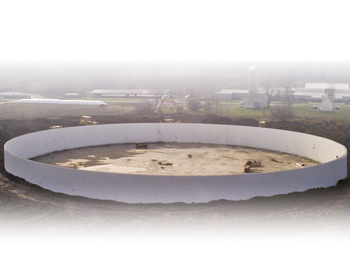
|
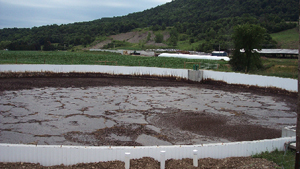 |
| This photo shows the completed wall structure of the Big White before the concrete was added to the interior of the PVC sheathing. The floor of the tank is 185-feet in diameter and required 540 yards of concrete. | New York State dairy farmers Mike and Peter McMahon recently constructed an environmentally compliant 3.2 million gallon concrete storage tank on their 1700-acre farm, located in the Scott Valley. |
New York State dairy farmers, Mike and Peter McMahon always knew constructing a new manure storage facility on their environmentally sensitive Homer-area operation was not going to be easy. The brothers’ three and a half year odyssey paid off with a new, environmentally compliant 3.2 million gallon concrete storage tank for the farm and a bronze award from the local American Concrete Institute chapter recognizing excellence in concrete design and installation for the project’s contractor.
Building manure storage capacity at McMahon’s E-Z Acres Farms had been a priority for Mike and Peter for several years. Since consolidating the farm’s registered Holstein milking herd into a six-row, free-stall barn in the mid 1990s, the family knew they had to address the need for additional manure storage capacity some day. With only about seven days of manure storage in the under-barn center collection manure pit, the McMahon’s were committed to year-round, daily manure spreading. And, after filing E-Z Acres’ CAFO plan in 2002, they knew the addition of at least a six month manure storage facility was required.
“For our CAFO, storage wasn’t an option, it was a must,” explains Mike, adding the farm had until October 2007 to address the storage capacity issue. The farm was also eligible for 70 percent coverage of expenses attached to the project.
| Big White wins design award McMahon’s E-Z Acres Farms’ manure storage facility is not your everyday 3.2 million gallon concrete tank: it is an award winner. The construction project, completed in late December 2006, recently received the bronze award for Excellence in Concrete Design & Installation from the Central New York Chapter of the American Concrete Institute (ACI). “It was the icing on the cake,” says Kevin McMahon, owner of Cortland, New York based KJM Contracting and general contractor for the project. During the awards ceremony, Kevin had an opportunity to view many of the other projects nominated for ACI awards. Most were civic projects, including large scale parking garages and high profile churches. “There was a lot of grumbling going on, wondering who would submit a manure pit,” he recalls with a laugh. “We felt like the bad boys of the competition. It may not hold 2000 cars or 2000 people in the congregation, but those other places can’t hold manure as well as our tank can.” This was the first Octaform manure containment system to receive a design and construction award, according to Octaform senior sales representative, James Johnson. “We were very excited and proud to be part of the award,” he says. “This creates a standard that our competition will need to strive to meet.” He was also full of praise for KJM Contracting, who orchestrated the build. “KJM did an incredible job as a first-time user of Octaform.” It was a sentiment shared by Mike McMahon, one of the owners of E-Z Acres Farms. “Kevin did an amazing job putting this together. It was quite a feat to pour the floor and the walls in extremely challenging weather conditions. It would have been even tougher without the Octaform system.” |
The design
From the beginning, Mike and Peter knew the storage would have to be constructed of glass lined steel or concrete. Given the gravel based soils of the Scott Valley, where E-Z Acres Farms is located, County of Cortland regulations forbid the use of earthen pits for manure storage. The farm is also located within an environmentally sensitive area of the state with 70 to 75 percent of the operation’s 1700 acre land base located above a sole source aquifer that supplies the town of Homer plus numerous private wells – in all, a population of about 20,000 people. Further complicating the issue was a protected trout stream – one of only nine naturally stocked streams found in New York State – which runs through the farm.
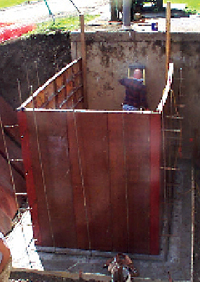 |
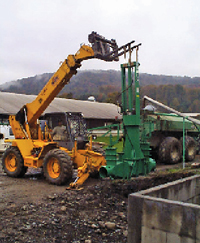 |
| Adjacent to the farm’s existing under-barn manure pit, a concrete bunker was constructed. It’s about 12-feet underground and houses the Houle piston pump that moves the manure from the barn pit to the new concrete tank. | The Houle piston pump is moved into place. The pump will be used to move manure from the under-barn manure pit to the new concrete storage tank. |
“If something went wrong with the aquifer or the trout stream, we knew who was going to be looked at,” says Mike, adding he and Peter decided to go ahead with a concrete structure. “We were looking at a 3.2 million gallon structure and poured concrete was considerably cheaper than glass lined steel.”
The pair decided to hire a professional engineer for the project and also brought in their brother Kevin, a building contractor based in nearby Cortland. Kevin was familiar with the farm operation, having been a partner in the operation for 10 years before leaving to start his own company, KJM Contracting, in 1990. “I’d been involved in other manure management projects but not to the level of this one,” says Kevin.
The planning process began in 2003 and “the environmental sensitivity of the farm location drove the whole project,” explains Kevin. The project required review by numerous government agencies, including the local county health department, soil and water conservation unit, environmental agencies plus anyone else who might have an interest in the project. Right away, the first hurdle was put in place. “They wanted to know what guarantees there would be that the concrete wouldn’t crack and leak,” recalls Mike.
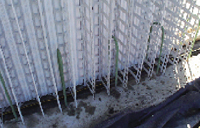 The PVC components of the Octaform tank serve as both the forming The PVC components of the Octaform tank serve as both the formingsystem and the permanent, watertight protective shell of the tank.
The Octaform build system Octaform tanks are made from a durable PVC stay-in-place concrete forming system. The steel reinforced concrete provides the strength and structure of the tank while the PVC is both the forming system and the permanent, watertight protective shell of the tank. The PVC cladding also helps protect the interior concrete from the corrosive effects of manure, water and other substances. Tanks can be built from 10,000 gallons to 10 million gallons in size and can be used for storing water, manure or agriculture chemicals. They are proven to withstand extreme climates, are quick and easy to construct, wash easily and never require painting. The components of the system can also be shipped very economically as they stack flat. |
The project team quickly began researching concrete treatments, mixes and coatings that could be applied to the structure to ensure it could not leak. But within days, an agricultural publication delivered to the farm mailbox supplied the answer. “On the back cover was an Octaform ad,” says Mike.
It was the first time either of the brothers had seen the system. They contacted the Canadian based company, which produces a stay-in-place, watertight concrete forming system using polyvinyl chloride (PVC) panels, and Kevin was soon traveling to central Canada to view Octaform storage tanks in use.
“He came back convinced this was the way to go,” says Mike. But having addressed the issue of possible wall leakage, government officials wanted guarantees on the integrity of the storage facility’s concrete floor.
The team decided to construct the storage tank on top of a 40mil (0.04in) landfill liner, supplied by A.H. Harris, which was placed under the concrete floor and around the structure’s footings. A series of collection pipes were also added between the liner and the floor. The pipes slope to the outside of the tank and feed into three dry wells, each wired with electronic flotation monitors. The devices feed back to a special monitoring room where readings are recorded weekly.
“It’s a closed loop system,” explains Mike, adding that if manure ever enters the monitoring wells, it will not be able to leave unless it is pumped out.
With these issues resolved, hopes were high the project would proceed. But in August 2005, northern New York State was the site of a large manure spill, caused by the collapse of an earthen dyke. The spill resulted in several million gallons of manure entering the Black River.
“The bar was raised for all dairy farms in New York,” says Mike.
Despite the fact the concrete walls of the tank were to be 10 inches thick and about 19 miles of steel rebar would be used to support the structure, the new question officials wanted answered was – how to guarantee the tank would not collapse or suffer a catastrophic structural failure.
“The only thing we could come up with was to set the thing underground,” says Mike. In a decision that added $130,000 in excavation costs to the project, about 30,000 yards of earth were moved by local contractor Randy Swan in order to construct the manure storage below grade. When completed, only two feet of the 16 foot high structure was above the ground, making it the first large Octaform tank constructed below grade.
As well, a 50 foot monitoring well was drilled on the down slope side of the storage tank. Water quality testing is performed every three months with the samples tested by an independent laboratory.
The build
After three years of planning and review, approvals were finally received for the project and construction on the storage facility began the beginning of October 2006.
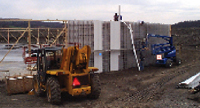 |
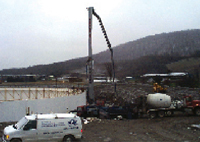
|
| Under the storage tank’s concrete floor is a 40-mil landfill liner to help provide a barrier against possible leaks. | In a perfectly orchestrated pour, 320 yards of concrete went into the storage tank’s 587-linear-foot walls. In total, about 1000 yards of concrete was used in the project. |
During the pouring of the structure’s concrete walls, Ed and Tim Dornn, from Manitoba, Canadian based Excel Construction – veteran Octaform tank builders – traveled to the work site to act as technical advisors. In a perfectly orchestrated pour, 320 yards of concrete, produced by Robinson Concrete Incorporated/Vitale Ready-Mix Incorporated, went into the 587 linear foot walls. Three weeks previously, about 540 yards of concrete was laid to form the tank’s 185 foot diameter floor. In total, about 1000 yards of concrete was used in the project.
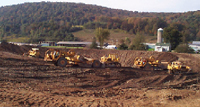 |
| About 30,000 yards of earth were moved in order to construct the manure storage below grade. When completed, only two feet of the 16-foot high structure was above the ground, making it the first large Octaform tank constructed below grade. |
The tank was completed by Christmas with the first manure entering the structure on December 28, 2006. “It’s one of the slickest things I’ve ever built,” says Kevin. “It was an amazing build. We’re happy with the job the Octaform product did. Our suppliers worked out well. Those three years of advanced planning really paid off.”
The concrete tank is located about 320 feet from the main barn, where a hole was cut into the side of the existing manure pit to accommodate suction lines. Nearby, a concrete bunker was constructed about 12 feet underground to house the Houle piston pump that moves the manure from the under-barn pit to the new tank. The distance between the two facilities allows for room to house future development, such as the addition of a manure separator or digester.
The storage structure, dubbed the Big White, was also constructed with top wall anchors in place to accommodate the future addition of a floating cover. The brothers hope to have it installed in 2008 as a tool for controlling odors. The cover would be used to collect gases for flaming or processing through a bio-filter and would also assist in keeping accumulated precipitation from filling up the tank. “During a year of regular weather in the Scott Valley, precipitation can add about 700,000 gallons of water to the 185 foot diameter tank,” explains Mike.
With the future addition of a cover, the McMahon brothers had to decide how they planned to agitate the manure in the storage facility. They could not mix from the top because of the cover. Instead, three chutes were constructed in a triangulated pattern around the circumference of the tank to accommodate three Houle PTO pumps, supplied by A.N. Martin & Sons. Each of the pumps has a pair of agitator guns at the end of it. One set of agitators sweep the bottom of the storage tank while the other two pairs point upward to move the upper levels of the liquid manure. According to Mike, each pump should be able to move 16 feet of manure about 120 feet, ensuring adequate mixing for proper land application.
“Even when stirring the pit, you can hardly smell anything more than if it was just being still,” says Mike.
 About McMahon’s E-Z Acres Farms About McMahon’s E-Z Acres FarmsMcMahon E-Z Acres Farms is a 2000 acre (300 acres are rented) dairy operation located in New York State’s Scott Valley in the County of Cortland, just northwest of Homer, New York. The farm is owned by Mike and Peter McMahon and currently milks about 675 registered Holstein cows with about 500 young stock. About 92 percent of the herd can be traced back to eight heifers the family started with on the farm just over 50 years ago. Peter and Mike bought the farm from their father in the 1980s when the operation milked 320 cows using four tie-stall barns, some of which utilized antiquated machinery. The brothers decided to modernize the operation and built a new free-stall barn in 1995. Most of the bull calves are sold at birth while heifer calves are hutch raised until they are seven weeks old. Then they are housed in a bedded pack barn before being moved to the replacement heifer herd at five months of age. The farm grows all of its own forages, including silage corn, alfalfa plus intensively managed grass. The operation is a case study farm for Cornell University, which is based about 27 miles away, and is the regular host of university classes plus visitor delegations from around the world. While the construction of the Big White means six months of storage for the main milking barn, E-Z Acres Farms will still have to deal with some daily manure spreading. The farm’s maternity and dry cow barn has about two months of manure storage in its under-barn pit as does the operation’s replacement heifer barn. The main milking herd is bedded on sawdust, which has worked out well for the brothers. “In the 12 years we’ve had the free-stall, there’s been no build up,” says Mike. The family has deep ties to the community with Mike serving 29 years on the county planning board plus serving on five other area boards and agencies. “This is our home, we grew up here,” says Mike. |
Life with the Big White
The addition of the manure storage facility has resulted in a few changes at E-Z Acres Farms, some positive and others not. “It’s added a new layer of management to the operation,” explains Mike. “After all, someone has to manage it.”
Every Monday, the condition of the dry monitoring wells and the monitoring instruments are checked plus the depth of manure in the storage tank recorded. As well, the area trout stream plus water quality monitoring wells located around the farm, including the new well drilled downstream of the manure facility, are tested every three months.
“The manure storage tank has also added a flexibility the farm operation never had before,” adds Mike. “Before, with only one week of manure storage, you would just be starting corn planting of 650 acres and you’d run out of manure to apply,” he says. It was also difficult to properly time the application of manure to freshly harvested grassland. “There never seemed to be enough manure when it was needed,” says Mike. “It’s changed that a lot.”
He admits some fine-tuning of manure delivery issues still need to be ironed out. E-Z Acres Farms recently purchased a tractor trailer with a 9000 gallon tanker to move manure from the storage tank to the field, where it is applied using a 4500 gallon Houle pull-behind field spreader, equipped with new drop-hose system on a 20 foot toolbar. During application, the manure is dribbled onto the ground and either incorporated with a disc ripper for corn land or left on top, in the case of grassland.